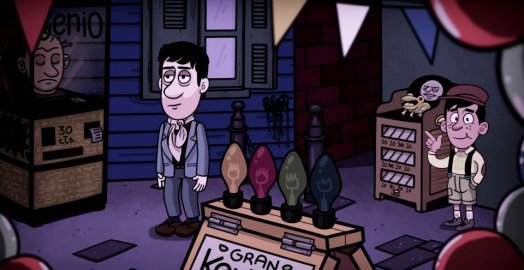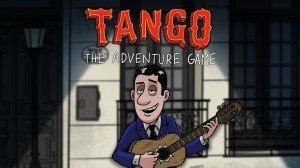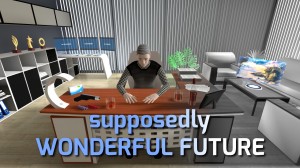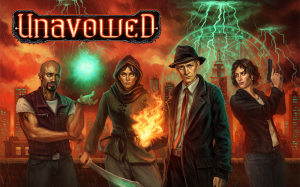Review for Tango: The Adventure Game

Most adventures trend toward the usual fantasy, sci-fi and detective genres, so I was pleasantly surprised to see that Tango: The Adventure Game tells a wildly different story based heavily on the life and work of history’s greatest tango singer Carlos Gardel. Partly fictional and partly biographical, this is an enjoyable adventure packed with Argentinian culture and history. What I wasn’t so thrilled to find out is that the story is unfinished, ending with many questions unanswered and clearly set up for a sequel. I also wish the puzzles were a bit more challenging and the overall experience longer, but the combination of unique art style, interesting characters, and use of 1930s tango music make it a worthwhile point-and-click that lovers of the genre should enjoy.
The beginning of Tango sees the main character Carlos, loosely based on Gardel himself, locked up in the world’s southernmost prison in Ushuaia for an unknown crime. After a series of simple introductory puzzles, Carlos tries his fourth escape attempt and finally succeeds, making his getaway with the help of his driver Santos. This, however, is not the start of Carlos’s story, and as he tells his tale to Santos, we are taken back in time to a bar to watch him hit rock bottom after losing his fiancée and all his money to the horse races. A final drink later and Carlos has a vision. There is only one way to get back the love of his life and relieve himself of poverty and vice: he must locate the magical tango lyrics that will bestow upon him a golden voice. As Carlos recovers from his bender we meet Lynch, a hardened stab-happy criminal who has been sent to beat Carlos down for money he owes to someone aptly named Big Tony. The rest of the game sees Carlos resorting to further gambling and petty con-artistry in search of his treasure and the promise of a better life.
Carlos makes for an engaging anti-hero, and I was immediately sympathetic to his strange, abstract quest for the magical tango lyrics. Although a petty criminal, generally he is a good-humoured, well-meaning gentleman who is occasionally funny, particularly in conversation with his unforgiving mafia associates. These ruffians – Lynch, Gustavo, Guillermo, Miguel and Dracu – all have their own well-developed personalities, and because they make up the majority of the supporting cast throughout the game, they add to the crime-heavy culture that Tango convincingly portrays. Other characters, such as the barkeep Tito and Big Tony, are not thoroughly explored for now, but the game clearly suggests they are key characters who could play a vital role in possible future instalments.
Although none of the characters are voiced, this is far from an issue, especially in the case of the protagonist, who is so expressive during conversation that he more than makes up for it. I actually preferred the text dialogue here, and I interpreted it as a deliberate tribute to silent cinema, of which Gardel was a star in the early 1900s. This theme is also supported by Carlos’s habit of breaking the fourth wall by looking directly at the player after a punch line, a genuinely funny throwback to classic slapstick comedy. Tango’s humour is not only built on references to early entertainment but also to the point-and-click genre in general, like a street sign that reads “SCUMMVM”.
As you might expect from a game named after such an iconic musical style, one of Tango’s best features is its audio, with a score that is strongly representative of 1930s Buenos Aires. It includes both original tracks as well as the works of Carlos Gardel, and you will likely recognize quintessential tango riffs throughout the game even if you aren’t explicitly familiar with his work. This music uses instruments such as the accordion, piano and most importantly guitar to give the game its own unique cultural charm and older-world feel that conjures up images of very early monochrome cinema and antique gramophones, both of which are emphasised in the game’s artwork.
The graphics are illustrated in a 2D cartoon style with a heavy dose of bleak colours and shades to create a sombre atmosphere. Although there is a small amount of exploration at the start of the game when Carlos is imprisoned at Ushuaia, the majority of places to visit are within the city of Buenos Aires, including the local racetrack, a couple of streets, the port, and Carlos’s residence and bar of choice, which are operated by his landlord Mona and friend Tito, respectively.
These characters, among others, bring life to Tango, and not just through interaction with them, but also because they are regularly animated within their environments. The aggressive knife-wielding Lynch, for example, is constantly playing the knife-between-the-fingers game while Tito obsessively scrubs away at the bar counter only a couple of meters away. Sometimes when puzzles are solved, Carlos is also animated, like when he uses a net to fish the seaside or plays a game of toad in the hole, involving throwing a coin at a wooden box. Key points in the story are also conveyed through animated scenes that are very well done. Examples include Carlos’s warped alcohol-induced epiphany and a horse race early in the game.
Using items is straightforward and the inventory appears as a band when the cursor is moved to the top of the screen. It is unobtrusive and allows you to single-click an item to look at it, or hold down the mouse button to drag it onto things to use or combine them. Every other non-inventory action, whether it is talking to someone or looking at/picking up an object likewise uses a simple left-click, making Tango as user-friendly as can be. Although getting around within a scene is simple, exiting buildings leads to a map of the street that shows where Carlos is currently located and allows you to select where to go next. In this way there is no central area Carlos noticeably walks through, which is somewhat peculiar because the map itself looks like it would have been well suited to a short jaunt between locales. In any case, the map does provide the benefit of fast-travel, making it exceptionally easy to get around.
Tango’s puzzles are mostly inventory-based and the majority of them can be solved without a great deal of thought, as they don’t deviate very much from the typical item-object combinations common to the genre. Having said this, some of them are still quite enjoyable, particularly a cocktail recipe puzzle where Carlos has to find three ingredients and then shake the shaker in a specific sequence, and another where you have to find a way of sabotaging Carlos’s rival at a tango sing and dance competition. Although I am partial to inventory puzzles, I found that I enjoyed the occasional non-inventory obstacles in Tango the most, especially one puzzle where you have to grift cards from a deck that Carlos is shuffling to help his mafia acquaintances. Regardless of the type, I would have preferred more puzzles overall, with a greater degree of challenge.
Although the characters, story, art and music of Tango are all of a very high standard, I was left feeling like it's more of a bite-sized series introduction than a full-fledged game in its own right at only a few hours of play time. Tango concludes on a cliffhanger, leaving many questions – including how Carlos came to be imprisoned at Ushuaia – a mystery. The circumstances at the end do a good job of setting the foundation for further interesting developments to come, and it would be rewarding to see how they play out in future instalments. Short-lived or not, there are a lot of good things about Tango: The Adventure Game, and I hope to see more of Carlos’s story down the road.
Our Verdict:
A point-and-click adventure based heavily on history’s greatest tango singer, Tango benefits from excellent production values and a promising story premise, though it turns out to be merely an abbreviated introduction with very little challenge so far.





























